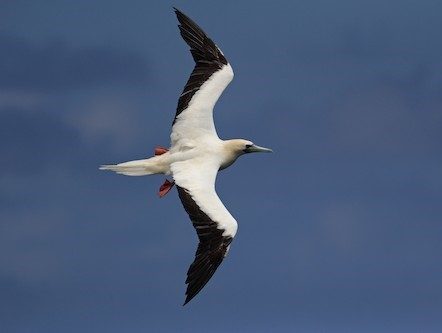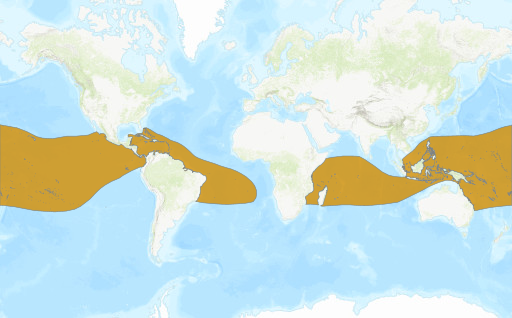Birdfinding.info ⇒ Locally common in its breeding areas, which are mostly islands of restricted or difficult access scattered across the tropical oceans. Its most accessible colonies are at Kilauea Point National Wildlife Refuge on Kauai and the Booby Pond Nature Reserve on Little Cayman. Elsewhere in Hawaii, it can often be seen from shore at Makapu’u Point on Oahu and Pauwalu Point on Maui—both sites are near breeding colonies. On the Big Island, it is regularly seen on pelagic trips from Kailua-Kona. Some Galápagos tours take visitors to the colonies on Genovesa (the world’s largest by far) or San Cristóbal. Other breeding areas that can be visited on tours include Isla Mona (west of Puerto Rico), Little Tobago (east of Tobago), Fernando de Noronha (northeast of Brazil), and Christmas Island (eastern Indian Ocean).
Red-footed Booby
Sula sula
Pantropical. Mainly pelagic and rarely seen from land except on its island breeding grounds.
Breeding. Nests mainly in bushes and trees, but also uses cliff ledges in a few locations. Most colonies are on remote islands.
The nominate subspecies, Sula sula sula, breeds on about 40 Caribbean islands (see map in Notes, below) and on remote islands of the tropical Atlantic: Fernando de Noronha, Trindade, and Ascension.
Rubripes breeds on islands of the Indian and Pacific Oceans. Indian Ocean breeding sites include Europa in the Mozambique Channel, several atolls in the Seychelles (especially Aldabra), the Chagos and Cocos Islands, Christmas Island, and atolls in the Timor Sea.
In the Pacific, rubripes breeds on most of the major tropical island groups from Iwo Jima and the Marianas south to New Caledonia and east to Hawaii and the Pitcairn Islands.
Websteri breeds in the eastern Pacific on several Mexican islands (Isla Isabel, the Trés Marías, San Benedicto, the Revillagigedos, and Clipperton) and to the south on Cocos Island (Costa Rica), the Galápagos (Genovesa and San Cristóbal), and Isla de la Plata (Ecuador).
Nonbreeding. Disperses widely across most areas of the tropical seas, but rare in the eastern Atlantic and northern Indian Oceans. Usually remains well offshore, but not averse to coastal sites. Immatures often wander and sometimes appear along temperate coasts, at least somewhat regularly in California, Japan, and South Africa.
Identification
The smallest booby and the most variable in appearance, with diverse color morphs that range from mostly white to all-brown. Some plumages are distinctive, but many are not. The adult’s red feet are diagnostic.
Has elongated central tail feathers, proportionately much longer than on other boobies. In most populations, the vast majority have entirely white tails, which is also diagnostic.
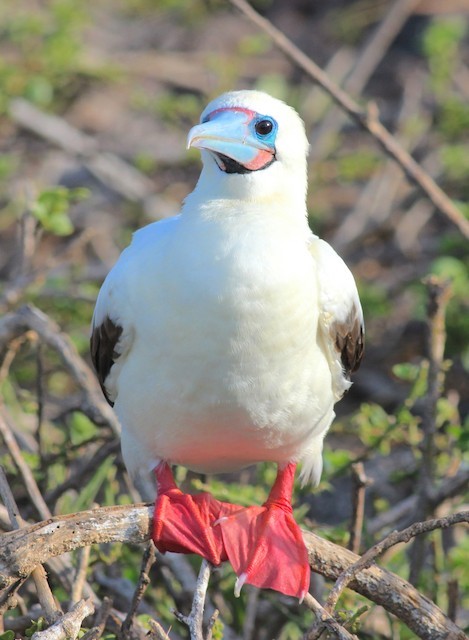
Red-footed Booby, white morph. (Darwin Bay, Isla Genovesa, Galápagos, Ecuador; May 21, 2014.) © Shawn Billerman
The bill is usually bluish, but can also be yellow. Facial skin is powder blue or turquoise around the eye and pink above and below, sometimes with a blackish border along the throat.
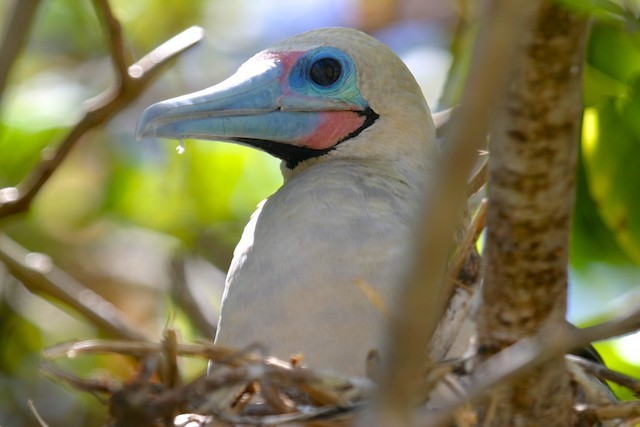
Red-footed Booby, dark-backed morph, showing the full glory of its multicolored facial skin. (Mabualau Island, Fiji; November 9, 2003.) © Bird Explorers
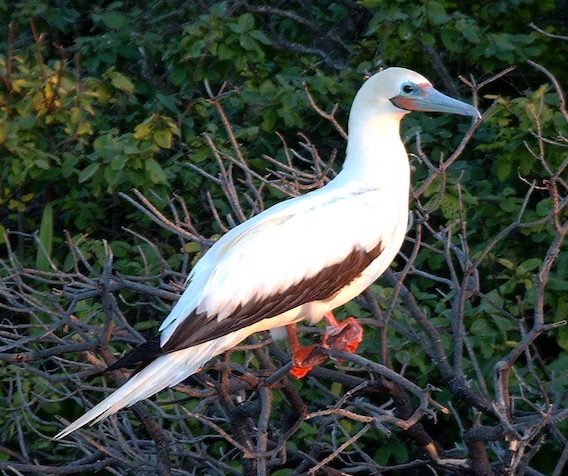
Red-footed Booby, white morph, showing the full length of its tail. (Lighthouse Reef, Half Moon Caye, Belize; December 23, 2003.) © Rick Lauzon
White Morphs. The typical white morph is distinctive: all-white with mostly black flight feathers—often with a yellowish tint on the head, somewhat like a gannet.
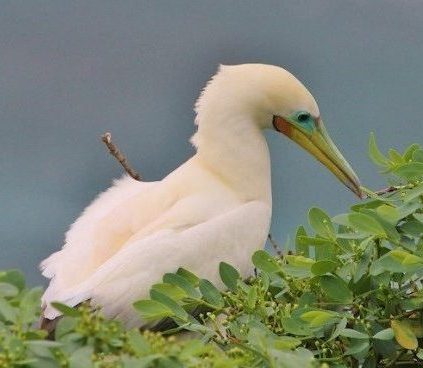
Red-footed Booby, white morph with yellow bill and strong yellowish tint on its plumage. (Kilauea Point National Wildlife Refuge, Kauai; February 22, 2018.) © John F. Gatchet
White morph variants may have either a brownish or black tail, or some amount of brown or gray on the back and wings.

Red-footed Booby, black-tailed white morph. (Prince Philip’s Steps, Isla Genovesa, Galápagos; January 14, 2006.) © Kimberly Rohling

Red-footed Booby, dark morph. (Darwin Bay, Isla Genovesa, Galápagos; May 21, 2014.) © Shawn Billerman
Dark Morphs. The typical dark morph is pale brown overall, somewhat darker on the wings and tail.
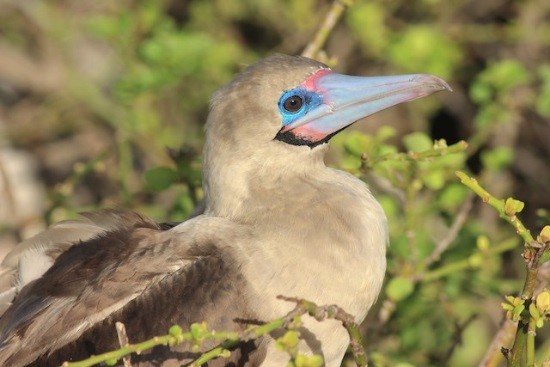
Red-footed Booby, dark morph. (Darwin Bay, Isla Genovesa, Galápagos; May 21, 2014.) © Shawn Billerman
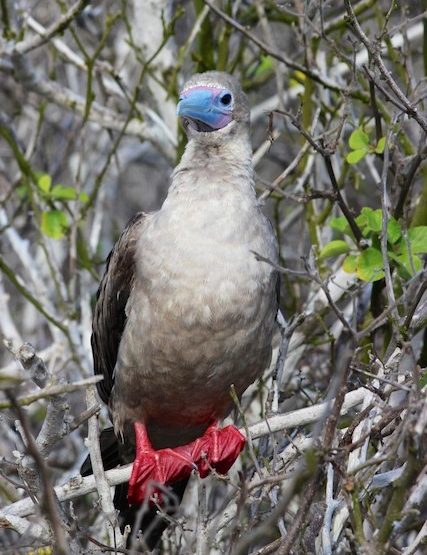
Red-footed Booby, dark morph. (Prince Philip’s Steps, Isla Genovesa, Galápagos; January 6, 2014.) © Nancy Cox
The most common dark morph variant (predominant in some populations) has a white tail, rump, and vent. In some, the white extends onto the lower back and scapulars.
Dark-backed Morphs. In the South Pacific, a large proportion of Red-footed Boobies have a gull-like pattern: mostly white or tan bodies with dark brown, or sometimes gray, back and wings.
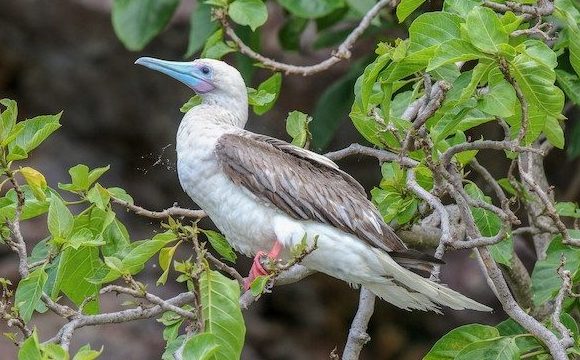
Red-footed Booby, dark-backed morph. (“Bird Island” between Ono and Buliya, Fiji; January 20, 2019.) © George Henry Stirrett
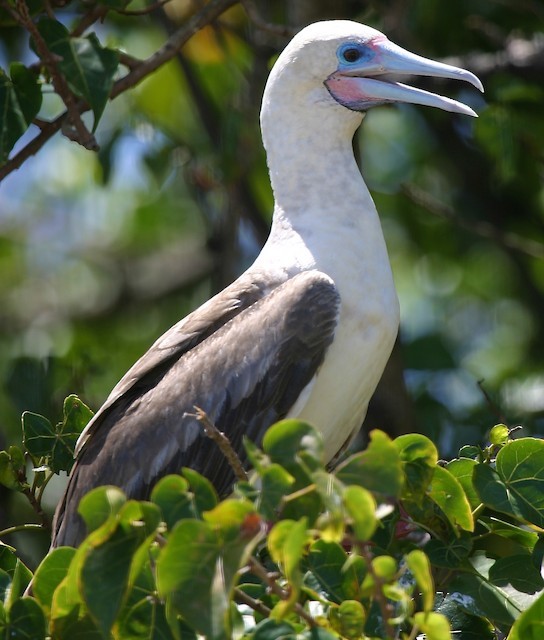
Red-footed Booby, dark-backed morph. (Mabualau Island, Fiji; November 9, 2003.) © Bird Explorers
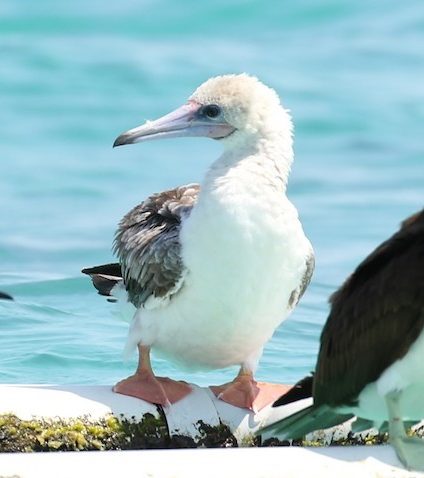
Red-footed Booby, intermediate morph, subadult, white with grayish back. (Michaelmas Cay, Queensland, Australia; November 19, 2017.) © Arco Huang
Immatures. Juveniles may be either dark brown overall or pale brown with darker wings, back, and tail. They have a distinctive narrow breastband that can be either faint or pronounced—a diagnostic feature. The bill and feet are dark gray.
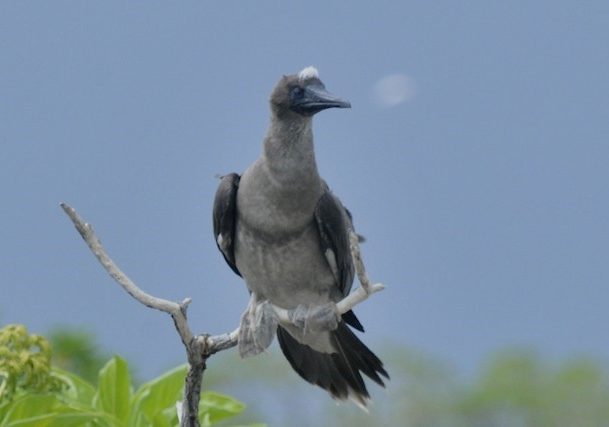
Red-footed Booby, juvenile with remnants of down. (Ngaontetaae Island, Kiribati; November 5, 2016.) © John Doty
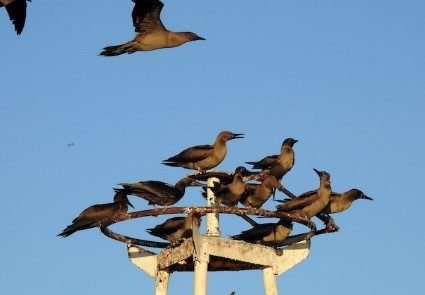
Red-footed Booby, dark morph juveniles, showing thin, slightly darker breastbands. (Darwin Bay, Isla Genovesa, Galápagos; December 10, 2017.) © David Bree

Red-footed Booby, juvenile. (Mabualau Island, Fiji; November 9, 2003.) © Bird Explorers
Older immatures may show nearly any variation of the plumage characters of juveniles and the various color morphs, but usually resemble one or another of the typical adult plumages. The feet begin to turn pink at any early stage. The bill remains gray longer than the feet, but lightens—although the tip usually remains dark.

Red-footed Booby, immature with pinkish feet. (Pilar Point Harbor, California; November 25, 2017.) © Brian Sullivan
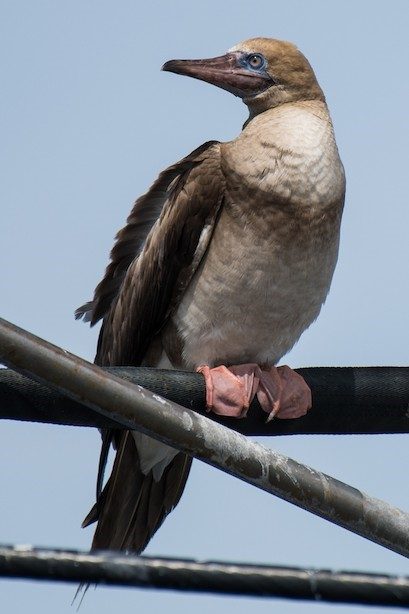
Red-footed Booby, immature with pink feet. (Mooloolaba, Queensland, Australia; March 4, 2017.) © Matteo Grilli
White Morphs in Flight. The upperwing of a typical white morph in flight is about 50/50 white and black, with a tapering boundary—at its base, the full width of the wing is white, then the black trailing edge begins and broadens toward the wrist.

Red-footed Booby, white morph. (West of Oahu; April 4, 2018.) © Eric VanderWerf

Red-footed Booby, white morph, showing yellowish tinge on head and tail. (Fernando de Noronha, Brazil; October 9, 2018.) © Carlos Gussoni
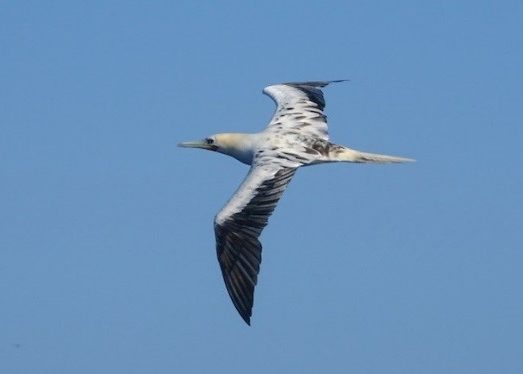
Red-footed Booby, white morph with gray mottling on upperparts. (Offshore from Kauai; April 3, 2016.) © Daniel Lane
The typical white morph’s underwing pattern is distinctive: white linings, black trailing edge, and an isolated black oval smudge just beyond the wrist.
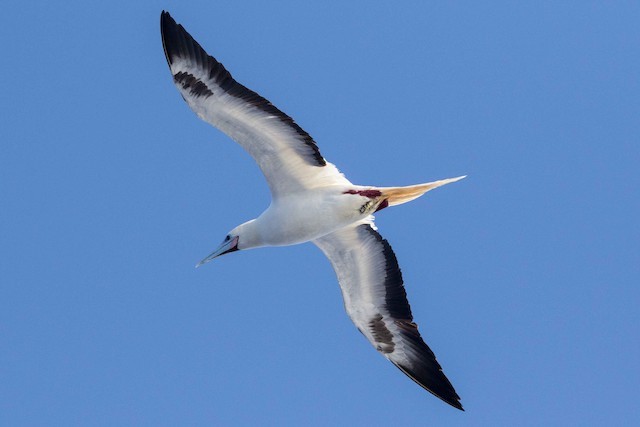
Red-footed Booby, white morph, showing distinctive black ovals on underwings. (West of Niihau, Hawaii; April 5, 2018.) © Eric VanderWerf

Red-footed Booby, black-tailed white morph, showing distinctive black ovals on underwings. (West of Niihau, Hawaii; April 5, 2018.) © Eric VanderWerf

Red-footed Booby, white morph, showing distinctive black ovals on underwings. (Kilauea Point National Wildlife Refuge, Kauai; April 26, 2011.) © Alan Selin

Red-footed Booby, white morph with unusually extensive black on underwing. (Offshore from Quintana Roo, Mexico; January 1, 2018.) © Douglas Faulder
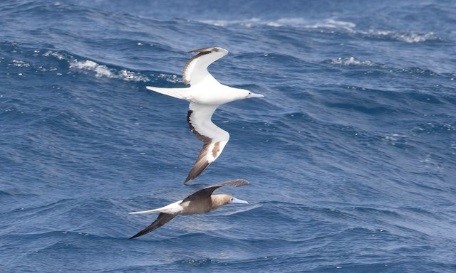
Red-footed Booby, white and white-tailed dark morphs. (Offshore from St. Vincent; March 7, 2018.) © Brian Sullivan
Dark Morphs in Flight. Dark morphs often show a hint of the same upperwing and underwing patterns as white morphs, but this is variable and the contrast is muted so it is usually difficult to discern.

Red-footed Booby, white-tailed dark morph. (Offshore from Aruba; October 19, 2009.) © Tom Murray
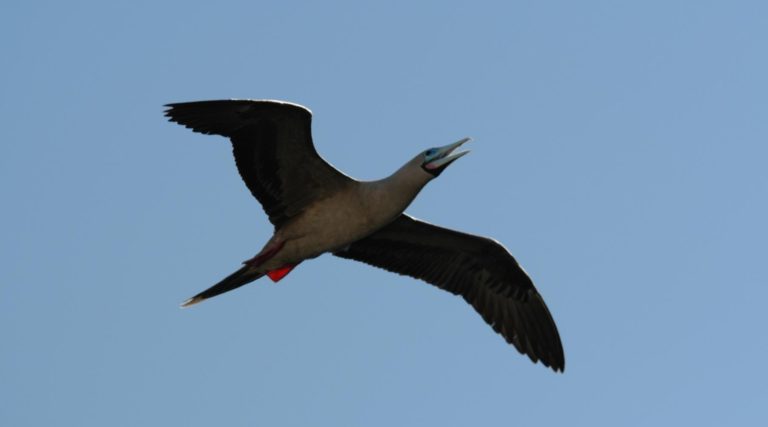
Red-footed Booby, dark morph. (Darwin Bay, Isla Genovesa, Galápagos; May 19, 2006.) © Marvin Hyett
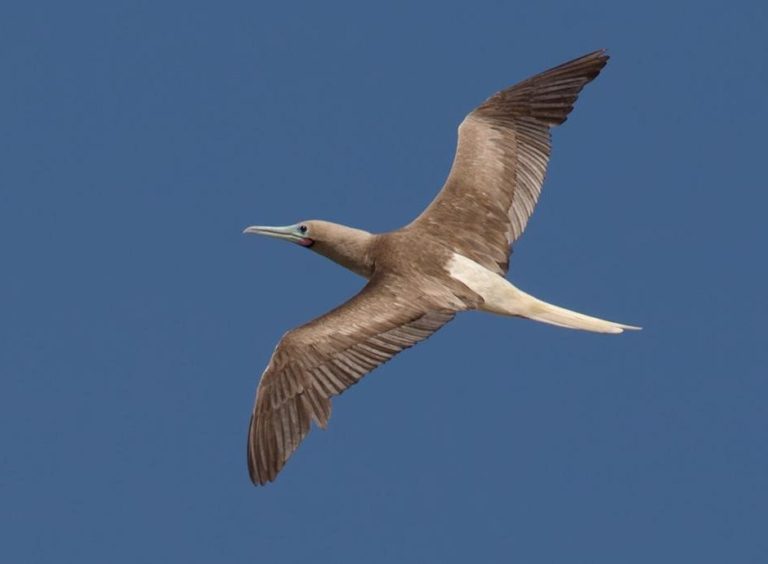
Red-footed Booby, white-tailed dark morph. (Tench Island, New Ireland, Bismarck Archipelago; July 13, 2014.) © Lars Petersson
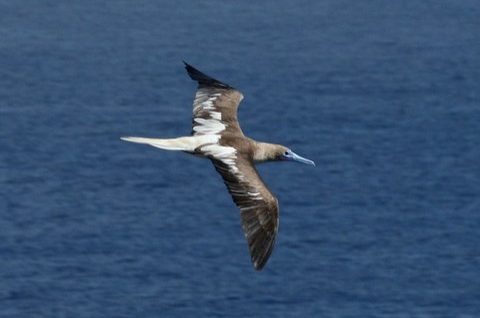
Red-footed Booby, white-tailed dark morph with white on scapulars and coverts. (East end of the Cayman Trench; December 16, 2007.) © Sam Stuart
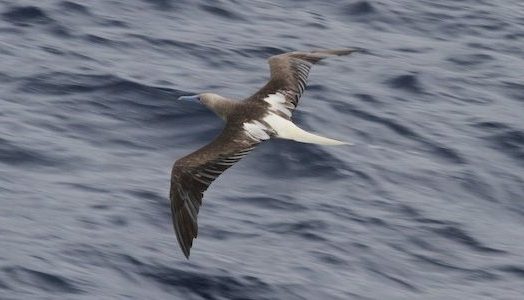
Red-footed Booby, white-tailed dark morph with white on scapulars. (Between Papeete and Moorea, Tahiti; February 7, 2013.) © Daniel Jauvin
Dark-backed Morphs in Flight. The various dark-backed and other “intermediate” morphs and subadult plumages show a wide array of wing patterns in flight.
Some are recognizable as Red-footed mainly by factors such as size and shape, and because they lack the characteristics of any other species.

Red-footed Booby, dark-backed morph—subadult with a dark tail. (Torres Strait, Queensland, Australia; May 7, 2017.) © Steve Murray
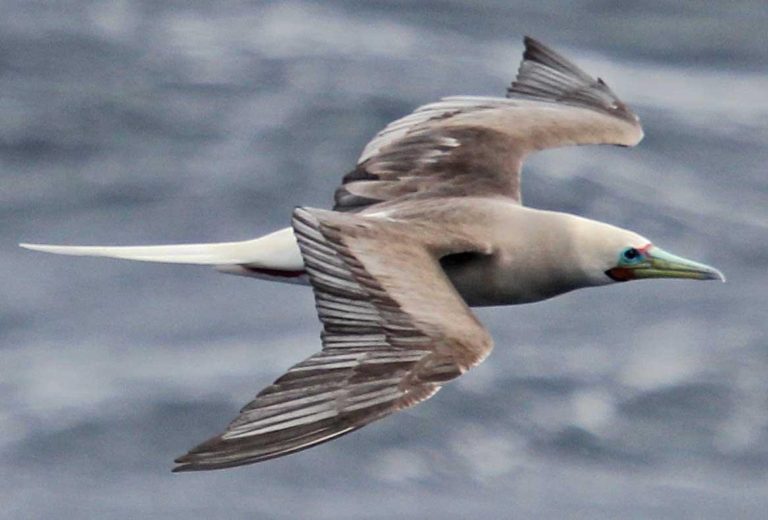
Red-footed Booby, an unusual intermediate morph. (Chesterfield Islands, New Caledonia; May 31, 2012.) © Julien Baudat-Franceschi
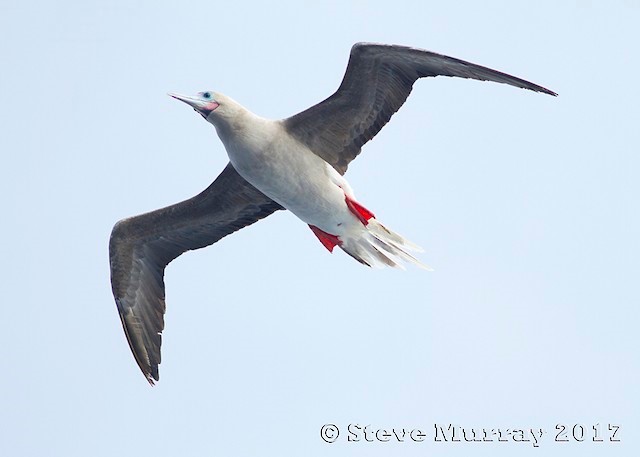
Red-footed Booby, dark-backed morph. (Coral Sea, offshore from Papua New Guinea; May 3, 2017.) © Steve Murray
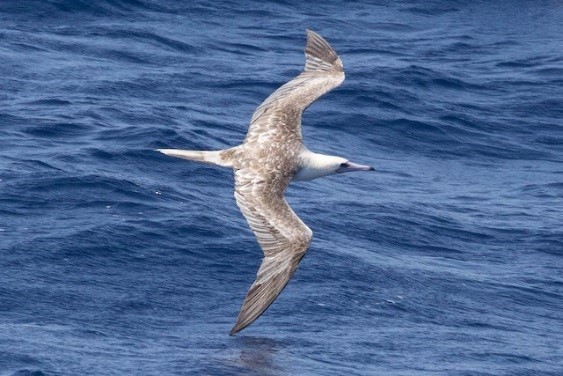
Red-footed Booby, dark-backed morph, subadult. (Offshore from Gardner Pinnacles, Hawaii; April 7, 2018.) © Eric VanderWerf
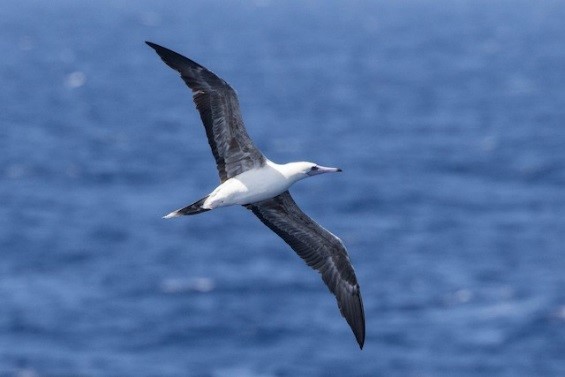
Red-footed Booby, dark-backed morph, subadult. (Offshore from Gardner Pinnacles, Hawaii; April 7, 2018.) © Eric VanderWerf
Immatures in Flight. Juveniles and other immatures are most readily recognized by their breastbands.
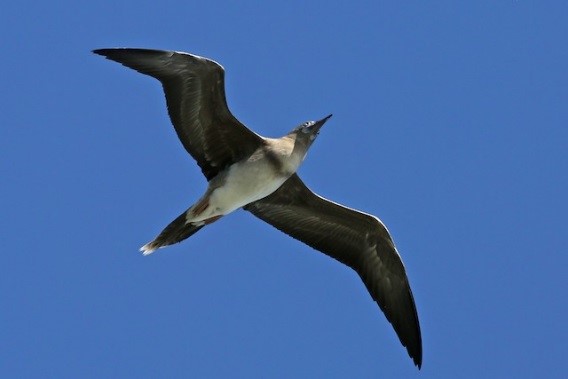
Red-footed Booby, juvenile showing diagnostic breastband. (Kilauea Point National Wildlife Refuge, Kauai; December 14, 2016.) © Laura Keene
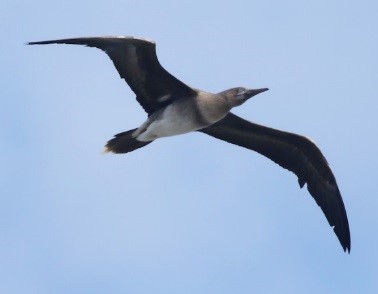
Red-footed Booby, juvenile showing diagnostic breastband. (Kilauea Point National Wildlife Refuge, Kauai; January 2, 2018.) © Derek Stokes

Red-footed Booby, juvenile—note the projecting pale tail-tip. (Offshore from St. Vincent; March 7, 2018.) © Brian Sullivan
In a dorsal view, they often appear all-dark, with mixed tones but lacking a discernible pattern. A subtle but consistent feature that appears to be diagnostic is the projection of pale-tipped central tail feathers.
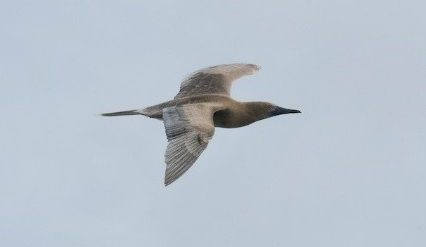
Red-footed Booby, juvenile—in a difficult perspective for identification. (Kilauea Point National Wildlife Refuge, Kauai; November 5, 2009.) © Ken Langelier
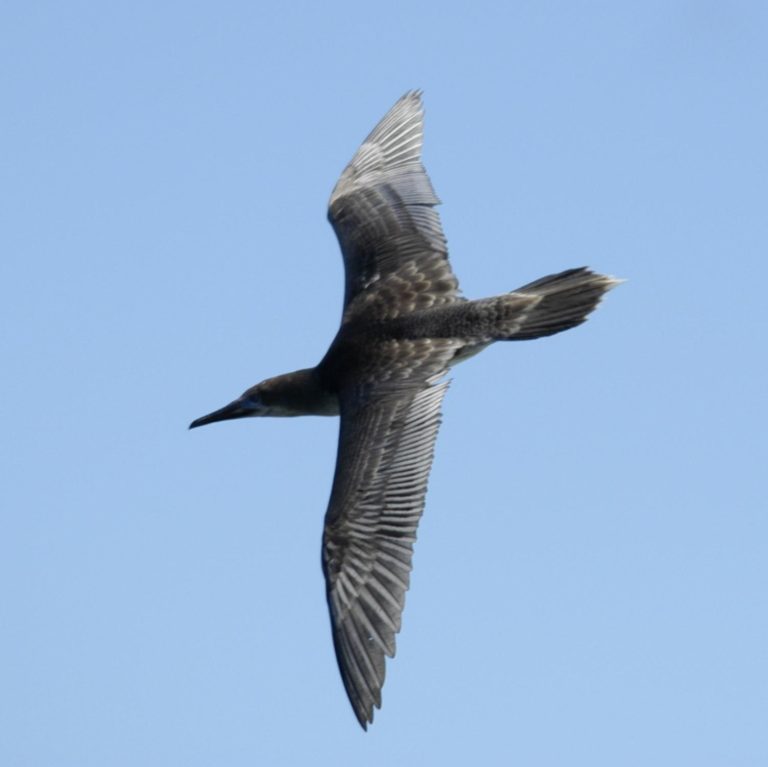
Red-footed Booby, juvenile—note the projecting pale tail-tip. (Kilauea Point National Wildlife Refuge, Kauai; February 14, 2016.) © Marvin Hyett
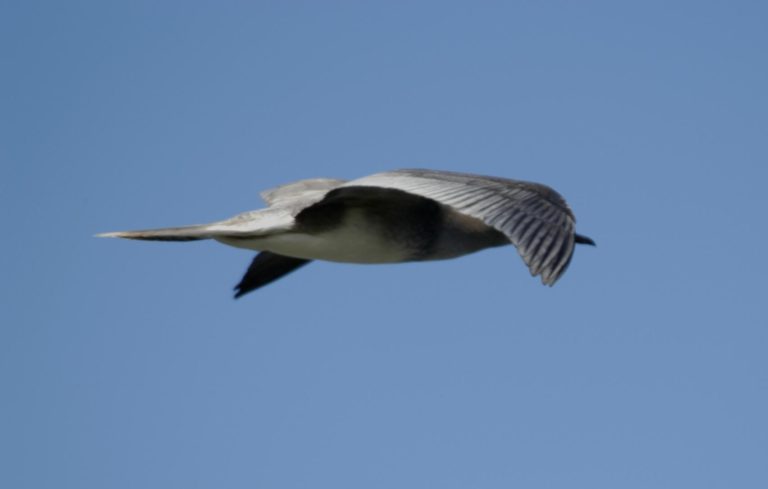
Red-footed Booby, juvenile—identifiable even in this suboptimal view by the projecting pale tail-tip and dark breastband. (Kilauea Point National Wildlife Refuge, Kauai; February 14, 2016.) © Marvin Hyett
Cf. Masked and Nazca Boobies. In most of its range, white morph Red-footed Booby is most likely to be confused with the much larger Masked and Nazca Boobies. All three are mostly white with some black on the wings. Coloration of the bare parts is diagnostic, but only visible at fairly close range. At a distance, the bare skin on Red-footed’s face can appear dark, resembling Masked and Nazca. When seen in flight, details of the wing pattern are usually the best indicators.
Dorsal Wing Pattern: On the upperside of Red-footed’s wing, the black trailing edge tapers and does not reach the body, whereas on Masked and Nazca, the entire wing has a black trailing edge.
Underwing Pattern: On the underside of the wing, white morph Red-footed almost always has an isolated black oval just beyond the wrist.
Tail Color: Red-footed Booby’s tail is usually white all the way to the tip. This is diagnostic when seen clearly; however, the black tip on Masked and Nazca’s tails can be hard to discern at a distance. An uncommon variant of Red-footed is white with a black tail, but on these birds the black area is more extensive than on Masked and Nazca.
Cf. Brown Booby. Immature and dark morph Red-footed can be all-brown or unpredictably mixed shades of brown, inviting confusion with juvenile Brown Boobies. Typically, juvenile Brown Boobies are darker than these Red-footeds and more uniformly colored above and below. As they age, immature Browns Boobies become distinctive as the belly lightens because the lighter area is sharply defined. Most juvenile Red-footed Boobies have at least a hint of a dark breastband. As they age, dark morph Red-footed Boobies turn coffee-colored rather than dark brown.
Notes
Polytypic species consisting of three subspecies: sula, rubripes, and websteri. The subspecies are sometimes regarded as distinct forms, but the main difference among them seems to be the relative prevalence of certain color morphs.
Caribbean Breeding Distribution.
Red-footed Boobies breed at approximately forty sites around the Caribbean, with the highest concentrations at Half Moon Caye (Belize), Little Cayman, Mona and Monito (west of Puerto Rico), the Grenadines, Little Tobago, and several Venezuelan islets.
There are smaller, but significant, breeding colonies on Navassa (west of Haiti), Dutchcap Cay (U.S. Virgin Islands), and Redonda (between Nevis and Montserrat).
Much smaller numbers nest at scattered outposts in the southwestern Caribbean, Campeche Bank (Arrecife Alacrán, in the Gulf of Mexico), the central Bahamas, and several additional islets in the Virgin Islands and Lesser Antilles.
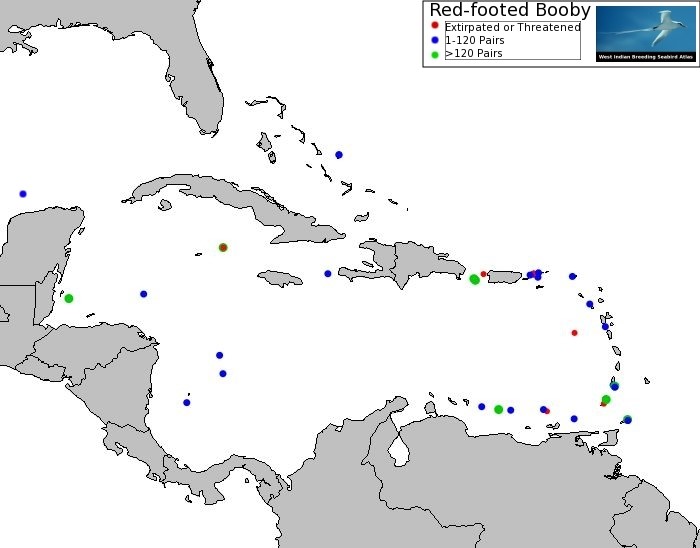
West Indian Breeding Seabird Atlas (www.wicbirds.net) 2009. © Will Mackin and David Lee
References
BirdLife International 2018. Sula sula. The IUCN Red List of Threatened Species 2018: e.T22696694A132589278. http://dx.doi.org/10.2305/IUCN.UK.2018-2.RLTS.T22696694A132589278.en. (Accessed February 1, 2019.)
Carboneras, C., D.A. Christie, F. Jutglar, E.F.J. Garcia, and G.M. Kirwan. 2018. Red-footed Booby (Sula sula). In Handbook of the Birds of the World Alive (J. del Hoyo, A. Elliott, J. Sargatal, D.A. Christie, and E. de Juana, eds.). Lynx Edicions, Barcelona. https://www.hbw.com/node/52624. (Accessed February 2, 2019.)
Clapp, R.B. 1987. Status of the Red-footed Booby Colony on Little Cayman Island. Atoll Research Bulletin No. 304. http://www.sil.si.edu/DigitalCollections/atollresearchbulletin/issues/00304.pdf. Smithsonian Institution. Washington, D.C.
eBird. 2019. eBird: An online database of bird distribution and abundance. Cornell Lab of Ornithology, Ithaca, N.Y. http://www.ebird.org. (Accessed February 2, 2019.)
Harrison, P. 1983. Seabirds: An Identification Guide. Houghton Mifflin, Boston.
Lee, D.S., and W.A. Mackin. 2009. Red-footed Booby. West Indian Breeding Seabird Atlas, http://www.wicbirds.net/rfbo.html. (Accessed May 15, 2018.)
Nelson, J.B. 2005. Pelicans, Cormorants and Their Relatives. Oxford University Press.
